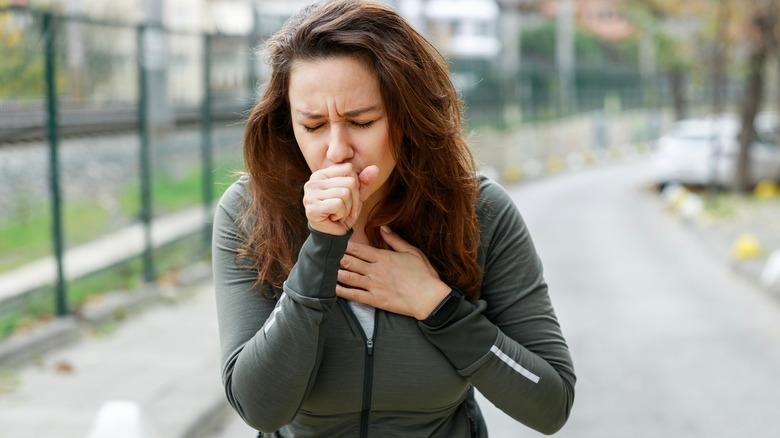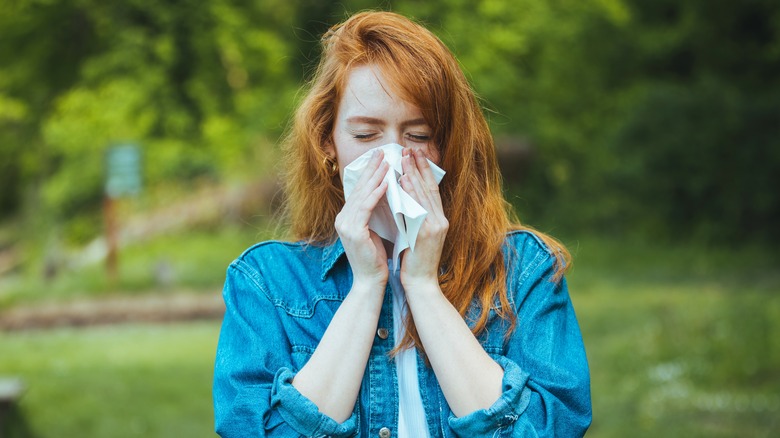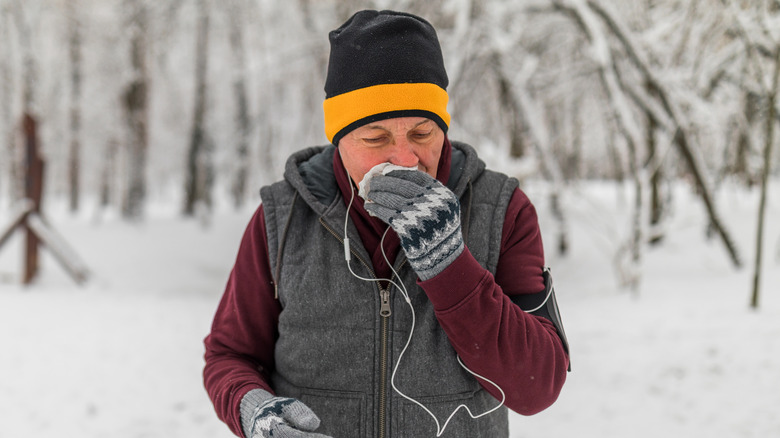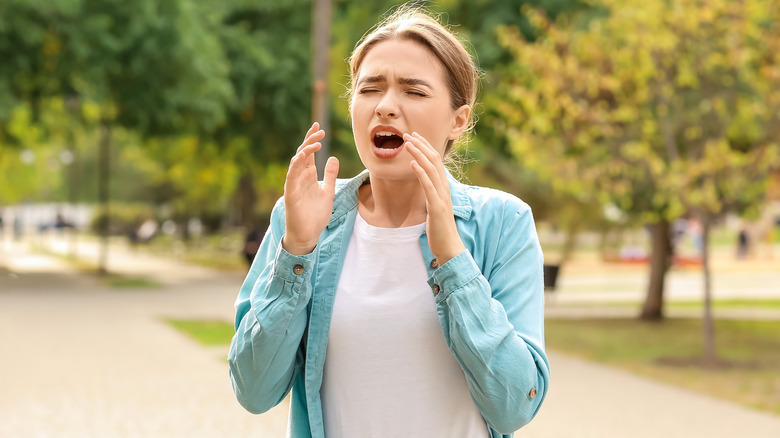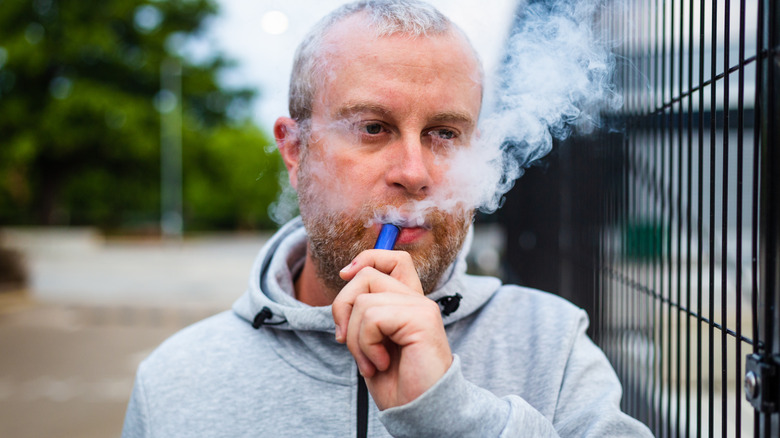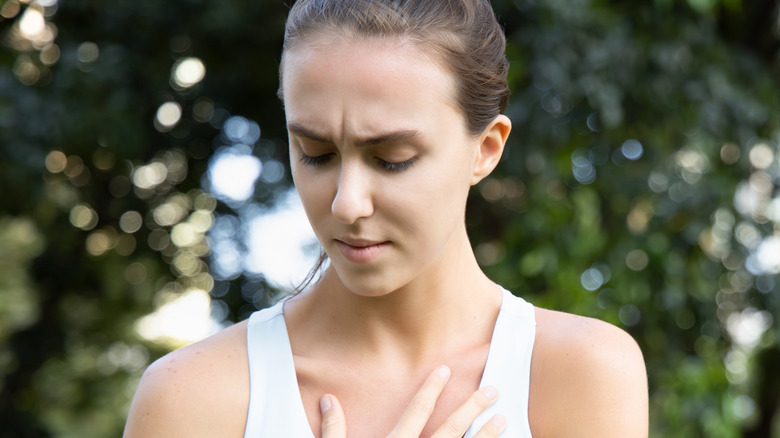What It Means When Exercising Makes Your Throat Phlegmy
You're about halfway through your run when you have to stop to cough. And it's not just a slight cough. It's a deep breathy cough that produces mucus. After a bit of heavy breathing, you get on with your exercise routine. However, after about a week, you're starting to wonder what's causing your exercise-induced phlegm.
It could be a number of things that are to blame; but, before diving into the potential causes of your cough and congestion, let's learn a little something about mucus and where it comes from. According to NIH News in Health, mucus isn't just thick gunk that makes you cough. It actually has a purpose in your respiratory tract. "Mucus is very important for filtering out materials that you breathe in through your nose, such as dust and allergens and microorganisms," says Dr. Andrew Lane, an ear, nose, and throat expert at Johns Hopkins University. Therefore, it provides a buffer between these substances and the moist surfaces of your respiratory tract by keeping everything lubricated and flowing well. Coughing helps to expel this mucus along with whatever germs or irritants are trapped inside it.
Now that you understand more about phlegm, we'll explore a few common reasons why you may be coughing it up when you're exercising. We'll also explain what you might be able to do to help the situation.
Allergies can be affected by exercise
You might not think too much about your surroundings when you exercise, but they could be the cause of your phlegm. The gym is typically full of chemicals used to disinfect the different machines which you could be sensitive to, while your morning hike opens you up to all the different allergens of nature.
Why do you have allergies? It's because your body comes into contact with a substance it considers foreign, typically through eating, breathing, or touching. The minute the invader enters your body, your immune system jumps into action by sending out antibodies to identify the substance, which causes you to be flooded with histamine. Within minutes, you can feel inflammation affecting your sinuses, skin, and possibly airways, states the Mayo Clinic. For example, you might start sneezing or notice your nose running. This postnasal drip can lead to phlegm and coughing as you work out. You might even experience watering eyes, notes the Cleveland Clinic.
Inhaled allergens like chemicals, pollens, and perfumes can be hard to avoid. Taking preventive action by using an antihistamine can make it easier to get through your run. It can also be helpful to avoid areas you know are triggers for you, like fields of dandelions. Visiting an allergist can help you to determine the allergen and prevent exposure to it if possible, per the Asthma and Allergy Foundation of America (AAFA).
Phlegm may be coming from postnasal drip
When you have a cold or sinus infection, it's easy to pinpoint where the phlegm is coming from. However, not all postnasal drip is due to a cold or allergies. According to Healthline, postnasal drip happens when your nasal passages are spurred into action to provide extra lubrication to filter out foreign matter. This extra lubrication accumulates in the back of your throat, leading to phlegm.
Beyond the obvious causes, cold temperatures or dry air can also affect postnasal drip. So, taking a run in the middle of winter might be the cause of your coughing fit since the air is both cold and dry. It can also increase due to pregnancy and medications, like birth control and blood pressure meds, says WebMD. It can also be irritants in the air like car fumes, smoke, or other chemicals. Those hitting the blacktop for a run in the city might encounter more air pollution, leading to phlegm buildup.
Paying attention to where you're exercising can help with the problem. For example, if you notice that dry air or air pollution seems to trigger you, then going to a gym or working out at home might be a better option. If you think your meds are the issue, it's best to talk with your provider to find a solution.
Exercise-induced bronchoconstriction can be a culprit
When exercise leads to excess phlegm and difficulty breathing, exercise-induced bronchoconstriction (EIB) may be to blame. According to the AAFA, more than 27 million people have asthma in the U.S., and it's more common in females than males. Additionally, they note that rates are highest among indigenous and Black individuals.
This type of asthma can only be triggered during physical activity. According to Johns Hopkins Medicine, the mechanisms behind this type of asthma aren't clearly understood. The American College of Allergy, Asthma & Immunology states it could be due to contaminants like chlorine from swimming pools or pollutants encountered while running. However, symptoms of coughing, wheezing, tightness, and phlegm start 5-20 minutes into an exercise routine. Johns Hopkins Medicine notes that symptoms are particularly triggered by strenuous exercise, even if it's short.
Once a healthcare provider diagnoses EIB, you might be given a fast-acting inhaler and long-term asthma treatment to keep symptoms at bay. It can also be helpful to take your time warming up and cooling down. Those exercising in cold weather can also wear a scarf over their mouth or use a device to keep the air warm and moist as they breathe in.
Respiratory ailments may trigger excess phlegm
Not everyone who hits the gym is feeling well. A cold or allergies are bound to make you produce more mucus than usual. But it could also be a respiratory infection that has you coughing up phlegm. For example, you might be suffering from bronchitis. This condition causes the bronchial tubes to become inflamed, leading to a cough and mucus production. According to the National Heart, Lung, and Blood Institute, you can also develop chronic bronchitis. Sufferers of this condition can experience symptoms every few months.
"Chronic bronchitis" is an umbrella term that includes chronic obstructive pulmonary disease (COPD), a group of diseases related to airflow blockage, according to the Centers for Disease Control and Prevention (CDC). The American Lung Association (ALA) notes exercise can improve oxygen use, energy levels, sleep, and cardiovascular fitness for those who have it. The ALA recommends stretching to improve flexibility and breathing, aerobic exercise to build the heart and lungs so they can use oxygen efficiently, and resistance training to improve muscle strength. It's important to start slow and breathe during exercise.
Another lung ailment, cystic fibrosis, is a condition where secretions of mucus, sweat, and digestive juices are thicker than average (per Mayo Clinic). It causes mucus to plug up airways and passages, leading to phlegm during exercise. However, daily exercise helps improve lung function and move the mucus out of the airways, according to the Cystic Fibrosis Foundation. They noted it's essential to stay comfortable when you exercise, though.
Smoking and vaping can cause phlegm issues
Smoking can lead to lung damage from the chemicals that are breathed in. In vaping, the heating process of making vapor can create products like formaldehyde and aluminum, which are dangerous to inhale, per the Canadian Lung Association. The lung damage can create excess mucus and a cough, which can affect exercise.
According to 2010 research in the Annals of Medicine, smokers have more phlegm production than those who don't smoke. They are also more likely to develop a chronic cough. The study investigated a cohort of military draftees in Finland by assessing physical fitness after running. In addition to having worse fitness, smokers had a higher body mass index and lower aerobic fitness. The study concluded, "The frequency of young smokers with chronic cough and sputum production was very high, posing a serious risk to their future health."
Those who have phlegm due to smoking will need to quit smoking or vaping in order for the symptoms to subside. The CDC also notes those that who quit smoking improve their health status and life quality, as well as their lung function and issues like COPD.
You could be suffering from acid reflux
Those who have acid reflux can also notice more phlegm in their throat when they start an exercise program or hit the gym too hard. Acid reflux happens when the stomach contents back up into the esophagus. It can lead to various symptoms like heartburn and indigestion, per Medical News Today.
Laryngopharyngeal reflux (LPR) happens when stomach acid backs up into the esophagus, causing damage. LPR comes with many symptoms like hoarseness, a lump in the throat feeling, chronic cough, excess mucus, and difficulty swallowing (per Cleveland Clinic). According to Digestive Health Services, when you exercise — specifically exercises like crunches, ab presses, or high-impact aerobics — it can cause your reflux symptoms to flare up.
However, low-impact aerobics and workouts can actually help to alleviate the symptoms of your reflux. So, if you're noticing an excess amount of phlegm in your throat, take your workout down a notch or two to see if that helps. It can also benefit reflux sufferers to avoid eating for a few hours before hitting the gym or pavement. Drinking water and taking over-the-counter meds like Pepcid or Zantac can also be beneficial. Digestive Health Services also recommends avoiding your typical reflux triggers and staying hydrated with water.

